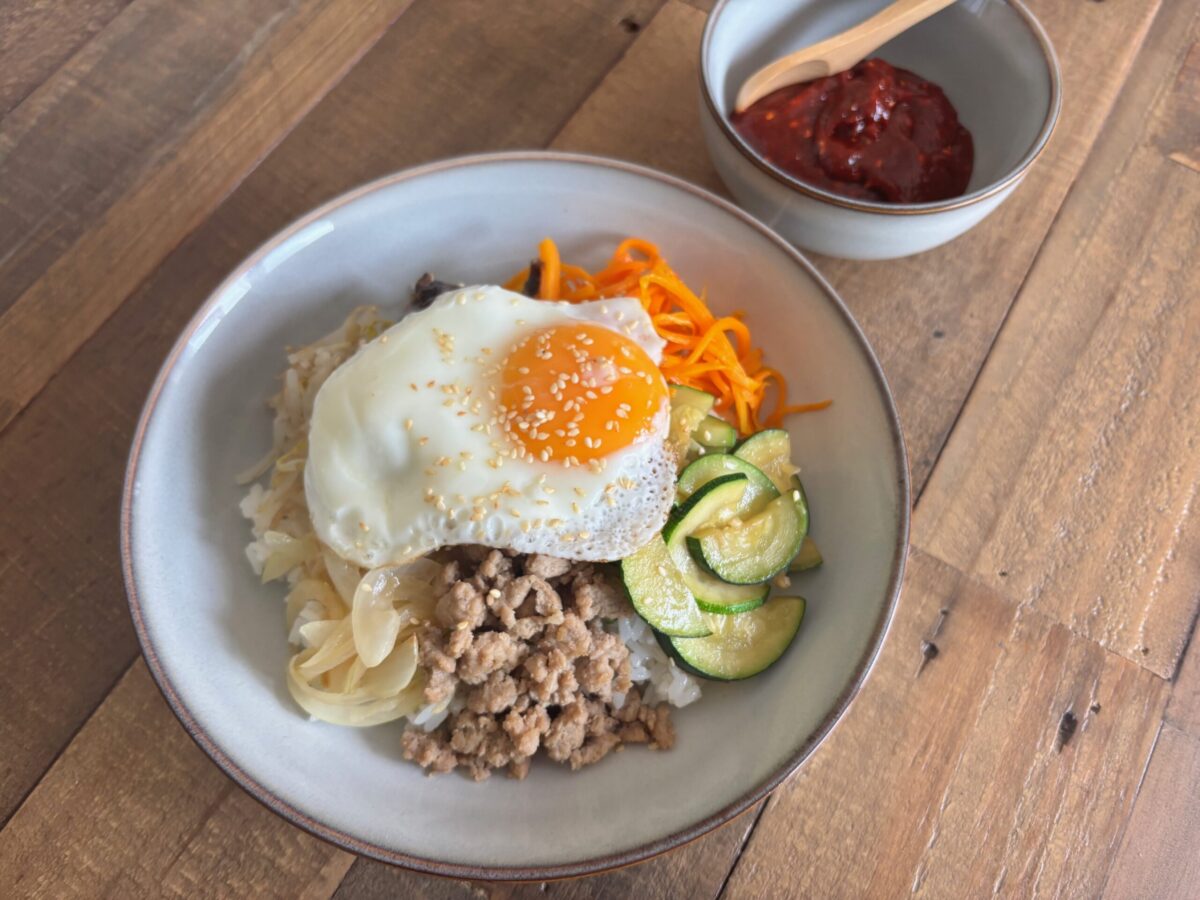Ingredients
Equipment
Method
- Prepare the Rice: Cook your rice and keep it warm. (Pre-cooked rice works perfectly too!)


- Marinate and cook the minced pork:
- Combine the pork with all the pork Marinade ingredients (soy sauce, sugar, minced garlic, sesame oil, and black pepper) in a bowl. Mix well and let it marinate for about 10 minutes.

- Prepare the Vegetables:
- Bean Sprouts: Bring a pot of salted water to a boil. Blanch bean sprouts separately for about 30 seconds to 1 minute until tender-crisp. Immediately rinse them in cold water and squeeze out any excess water.

- In separate bowls, season each with 0.5 tbsp minced garlic, a pinch of salt, 0.5 tbsp sesame oil, and a pinch of toasted sesame seeds. Gently mix by hand.

- Zucchini: Slice the zucchini thinly into half-moons or julienne strips.

- Mushrooms: Remove the stems and thinly slice the mushrooms.

- Carrot & Onion: Julienne the carrot and onion.

- Heat a pan with a little cooking oil. Sauté the zucchini with a tiny bit of minced garlic until tender. Season with salt or soy sauce.

- Heat a pan with a little cooking oil. Sauté the mushrooms with a tiny bit of minced garlic. Season with 0.5 tbsp soy sauce.

- Also, lightly sauté carrots and onions separately in a pan with a little oil and salt, or serve them raw for a crunchier texture.

- Heat a frying pan with a little cooking oil. Sauté the marinated pork until fully cooked and browned. Transfer to a separate plate.

- Fry the Eggs: Heat a frying pan with a little cooking oil. Fry the eggs sunny-side up or over easy, so the yolk is still runny. (A runny yolk adds richness when mixed into the bibimbap!)
- Make the Bibimbap Sauce: In a small bowl, combine Gochujang, sesame oil, sugar, minced garlic, vinegar (if using), water/dashima broth, and toasted sesame seeds. Mix thoroughly until smooth. Adjust the consistency with more water/broth if it's too thick.

- Assemble Your Bibimbap:

- In a large serving bowl, place a generous portion of warm cooked rice.
- Arrange the prepared ingredients beautifully on top of the rice, separating them by colour: the cooked pork, bean sprouts, zucchini, mushrooms, carrots, and onions.
- Carefully place the fried egg in the center.
- Sprinkle with shredded roasted seaweed and whole toasted sesame seeds.
- Generously spoon the prepared Bibimbap Sauce over everything.
- Enjoy! With a spoon, mix all the ingredients and the rice together thoroughly. Enjoy your delicious and healthy homemade Bibimbap!

Notes
Tips for International Cooks:
Spice Level: You can adjust the amount of Gochujang according to your preference. Suggest starting with a smaller amount and adding more as they mix if they like it spicier.
Protein Alternatives: Mention that pork can be substituted with beef, chicken, or even tofu for a vegetarian option.
Visual Appeal: Emphasize that Bibimbap is also a feast for the eyes! Encouraging them to arrange the colourful vegetables neatly makes the dish even more appealing.
additional vegetable options
-
Spinach (시금치)
- Blanch and season with garlic, sesame oil, and salt.
-
Fernbrake (고사리, Gosari)
- A classic mountain vegetable used in traditional bibimbap.
-
Bellflower root (도라지, Doraji)
- Slightly bitter; often stir-fried.
-
Radish (무)
- Julienned and stir-fried or pickled (like mu-saengchae).
-
Cucumber (오이)
- Julienne and lightly salted or quickly stir-fried.
